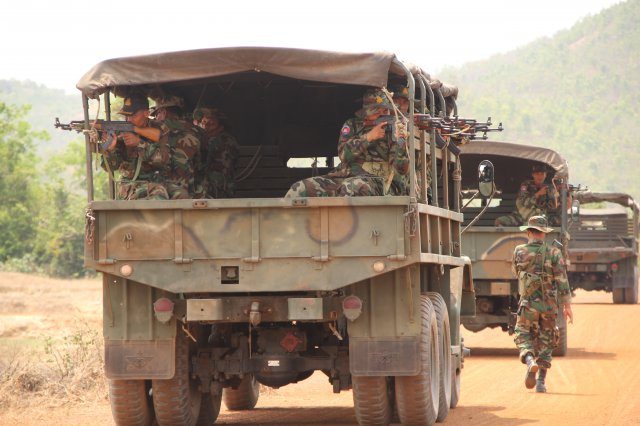Trainers from the Asia Pacific Counter Improvised Explosive Device Fusion Center based at Fort Shafter, Hawaii, helped prepare Cambodian peacekeepers for future United Nations humanitarian missions.
The engagement was part of Angkor Sentinel held March 13-23, which is an annual exercise between the United States Army Pacific and the Royal Cambodia Armed Forces. The bi-lateral exchange, now in its third year, promotes cooperation, stability, and capacity building between the two nations.
Master Sgt. Brandon Jackson, team leader for the center, said his group trained over 200 Cambodians in counter improvised explosive device, or IED, awareness, mounted and dismounted tactics, and search procedures. Some of those instructed will likely be deployed for some type of United Nations peacekeeping operation.
“We gave them a base knowledge of what to look for, and what to do if there is ever a threat,” said Jackson.
Maj. Gen. William Beard, deputy commanding general for United States Army Reserve, U.S. Army Pacific, visited the training March 21. He spoke of the center’s importance, and what it means to our partner nations.
“Improvised explosive devices are the chosen weapon for terrorists and violent extremist organizations, and we’re doing something here to combat the threat. Our loyal partners [the Cambodian Armed Forces] are serving as peacekeepers in some dangerous places, and the training that took place during this part of Angkor Sentinel, will one day pay dividends. I’m sure of that,” said Beard.
Lt. Gen. Sem Sovanny, director-general of the Cambodian National Center for Peacekeeping Force, said in a February interview with the Chinese news agency Xinhua, that Cambodia plans to send more than 200 medical and military police to Sudan in late March or early April. According to statistics with the United Nations, Cambodian peacekeepers have provided humanitarian support in Central African Republic, Chad, Haiti, and are currently in Lebanon and Sudan.
Cambodian Colonel Chuon Savy, who deployed to Sudan in 2006, said the new peacekeepers can expect dangerous conditions in the sand covered country.
“Before any road can be paved, any bridge can be built, or any building erected, you have to clear mines that litter the land from years of civil war. Six years ago our mine detectors couldn’t detect the metal in the small anti-personnel mines, and so our soldiers had to clear by hand, sometimes moving only three meters a day,” said Chuon, who wrote the standard operating procedures for the U.N. de-mining mission back then.
According to the Center’s lesson plan for Angkor Sentinel, counter IED instruction involved classroom work in which some of the material was printed in Khmer, the Cambodian language. The instruction then moved outdoors in the 95-plus degree heat for much of the practical application phase. This involved riding in trucks as part of a convoy, and also moving on foot patrol, said Jackson.
“Our plan was to implement a train-the-trainer course that builds counter IED capacity within their own country. We gave them the basic tools and then let them do it on their own. I must say they did a great job,” said trainer Anthony Perez.
Perez went on to say that once he and his team trained up a cadre of teachers, they [Cambodians] were taking over much of the instruction. By the last few days of the exercise it was pretty much Cambodian led, said Perez.
“That is what we hope to achieve in all of our partner nation exchanges, the ability to go in, get their trainers up to speed, and then sit back and watch them do it.”
The Asia Pacific Counter-IED Fusion Center uses the latest intelligence and threat reporting to provide theater specific, customized C-IED training and solutions to United States assets and partner nations. In 2011, the Center trained more than 7,000 American forces, and conducted exchanges with more than 700 allied and partner-nation personnel.











